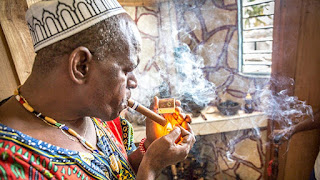 Today I am feeling spiritual for many reasons, which has reminded me of my own spiritual curiosity in Cuba; it is also fitting that today is the Day of Shango. One of the most interesting things I discovered while living in Cuba was uncovering the Yoruba religion or what is known as Santeria in North America.
Today I am feeling spiritual for many reasons, which has reminded me of my own spiritual curiosity in Cuba; it is also fitting that today is the Day of Shango. One of the most interesting things I discovered while living in Cuba was uncovering the Yoruba religion or what is known as Santeria in North America.Santeria, also known as Regla de Ocha is an African-Cuban religion developed by West African descendants, most notably Nigerian slaves that had been forced to work in Cuba during the Spanish empire in the sugar plantations. Santería’s roots can be traced to the Lucumí religion, which was practiced by the Yoruba tribes of modern-day Benin and Nigeria. The slaves were banned from practicing their own religion, so this was practiced in secret, and survived orally from one generation to another, disguising their gods as Catholic figures continuing to pray to them as they pleased. Santería – meaning Way of the Saints – are Catholic saints that represent Yoruban divine beings, known as Orishas. Today Santeria is the number one religion in Cuba and it is estimated that up to 80 percent of Cubans follow some form of the practice.
Those that follow Santeria believe Olodumare (God) created the universe and the Orishas are deities that personify some aspect of nature and spirit along with certain human characteristics. For example, today on the Day of Shango who is the orisha of thunder and lightning and is syncretized with Santa Barbara; daughters and sons of Shango should provide him with flowers, candles, fruits, coconuts etc to show their appreciation for his blessings. Just like many other traditional healing practices in North America, Santeria's focus is to achieve harmony and balance in life. Followers are not able to communicate directly with these divine beings, so in Cuba, priests that are able to hold rituals and ceremonies are known as Babalawos who act as intermediaries in the religion. They interpret the will of the gods using divination, which involves an elaborate ceremony that may last days and includes, amongst other things, dance, drums, blessings and animal sacrifice.
I must admit all of this was quite fascinating to me while living in Cuba and usually invited over Babalawos and other religious followers to teach the American students I worked with, on the fundamental aspects of the religion, one of the best ways to immerse yourself in a culture.
It was hard to not notice the remnants of the religion scattered all over Havana. You would almost always find some type of 'ebbo' (offering of fresh fruits, ritual baths, cooked foods, or animal sacrifice) wrapped in newspaper and strewn on corners, under trees, up hills etc. My curiosity just seemed to grow, and which made me see firsthand many forms of the religion. Today in Cuba, orishas are important in performing miracles and solving problems and most people, in times of need, turn to their Padrino (godfather who is a Babalawo) to help them appease their orishas. As mentioned above, this appeasement comes in some type of 'ebbo' or cleansing that ensures that the orishas are always being looked after.
Next time you are in Cuba and in particular Havana, take a look around and notice your surroundings, you will surely see some form of the religion before your eyes. From the ebbos on the street corners to the drumming coming from the homes from rituals and ceremonies taking place, to the Cubans only wearing white attire. This religion is one of the most important aspects of Cuban culture and everyday life. It is this faith that keeps Cuban's resilience high in face of life's' adversities.
Thanks for taking the time to read my blog....


Comments
Post a Comment